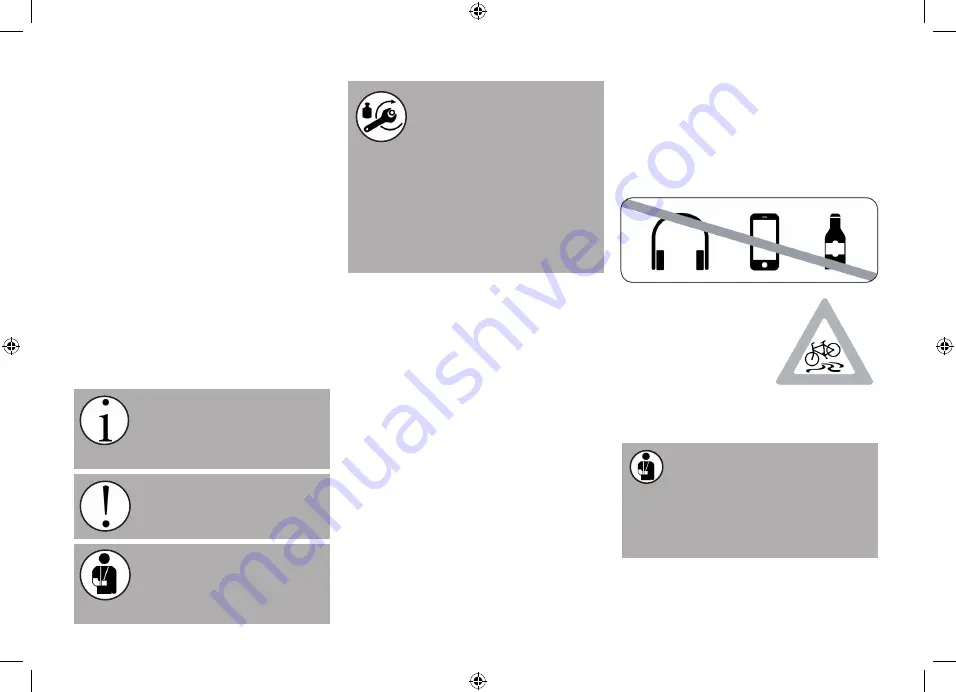
3
Safety information
Please carefully read all warnings and notes in
this operating manual before using the bicycle.
We recommend keeping the manual close to
your bicycle, so that it is always at hand.
Please ensure you read the chapters “Be-
fore the first ride” “Before each ride” before
using the bicycle for the first time!
If you lend your bicycle to a third party, please
give them this operating manual with the bicycle.
This operating manual contains different types
of pointers – one providing important informa-
tion about your new bicycle and how to use it, a
second referring to possible damage to property
and the environment, and a third type warning
against potential falls and serious damage, in-
cluding physical injury. If you see this symbol,
there is always a risk that the danger described
can occur! The text which the warning covers al-
ways has a grey background.
The warnings break down as follows:
Information:
This symbol provides
information about how to use the
product or highlights specific parts
of the operating manual that are
particularly important.
Warning:
This symbol is aimed
at warning you against improper
use that could result in damage to
property or the environment.
Danger:
This symbol indicates
possible dangers to your health
and life that could arise if specif-
ic actions are not taken or corre-
sponding regulations adhered to.
Important bolted connection!
Please adhere to the exact recom-
mended torque when tightening
this connection. The correct mount-
ing torque is either displayed on the
component or listed in the table of torques on
page 37. A torque wrench has to be used to
achieve the precise prescribed torque. If you
don’t own a torque wrench then you should
always leave this work up to a specialist retail-
er! Parts which do not have the correct torque
could fall off or break! This can result in seri-
ous accidents!
Check that all quick releases are safe and se-
cure every time you ride after your bicycle was
unused, even for a short period of time! Regularly
check that all bolts and components are secure.
Note that components made of composite
materials, i.e. carbon fibre, often require a lower
tightening torque. See page 37. Common parts
made of carbon fibre include the handlebars,
stems, seat posts and saddle rails, frames, forks
and cranks. Ask your specialist retailer to instruct
you on how to properly use and maintain these
materials.
These operating instructions are based on the
assumption that you can ride a bicycle. These
are not instructions to learn how to ride a bicycle.
They are also not intended to provide information
on how to assemble or repair the bicycle.
Please be aware that riding a bicycle involves
some basic risks. You, the bicycle rider, are ex-
posed to particular risk. Always remain aware that
you are not as protected as you are, for example,
in a motorcar. You have no airbag and there is
no car body. You are nevertheless moving faster
and in other parts of the road than a pedestrian.
You should therefore pay special attention to oth-
er road users.
Never use headphones or a mobile phone
while riding a bicycle. Never ride when you are
not able to keep full control. This applies, in par-
ticular, after taking medication or consuming al-
cohol or drugs.
• Please adapt your riding
style to the conditions
when the road is wet or
slippery. Ride more slowly
and brake earlier, as the
braking distance will be
significantly increased.
• Adapt your speed to the
terrain and your riding skills.
• Never ride with your hands off the handlebars.
Modern bicycle technology is high
tech! Working on bicycle parts there-
fore requires special knowledge, ex-
perience and specialist tools! Please do not
attempt to work on the bicycle yourself! Give
your bicycle to a specialist retailer for repair,
servicing and maintenance!
IDEAL MANUAL 2016_eng.indd 3
6/27/16 11:39










































